-
Saturday 1st October 2011
Saturday saw us on the move again. We're on a fairly tight time schedule at the moment as we want to be back in Australia before the cyclone season starts. Technically the 1st of November is the official start but we're pushing our luck by a week and not planning to arrive until around the 6th of November. Having said that though, it's not a date that we can guarantee since we're so dependant on weather and with all the stories we've heard of people having really bad passages between Vanuatu and Australia, we'll be watching for the perfect weather window before we set off.
We arrived in Navadra Island after a short motor sail from Mana Island. Navadra Island is a beautiful, uninhabited island that is wrapped around a little horseshoe bay that's open to the north and gives great protection from most of the prevailing winds.
The island is fringed with beautiful coral reefs and we took a couple of hours out of our day to go snorkelling on the western side of the bay. The coral and marine life was astounding. The coral gardens were in about 5-8m of depth which made the colours really well defined and made it easy for all of us to dive down and enjoy the magnificent corals. We dove for about 20minutes, but as the tide started to come in, the water silted up, so visibility dropped off rapidly. We swam back into the dinghy and motored deeper into the bay and went diving there. The water here was a little deeper, so after dropping off the rest of the family I went back to “Connect4” and collected my new SCUBA gear that I'd been looking for a chance to use. I hadn't proven the equipment, so I was keen to dive in a sheltered, shallow area where I could get back to the surface if anything malfunctioned.
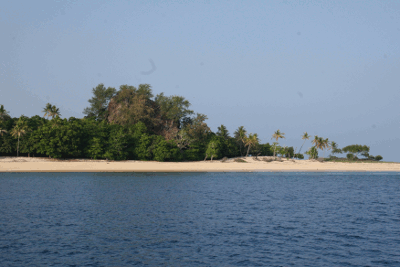

I haven't dived in a good many years, but I remembered how to set up and check all my equipment. When I put on the weight belt and tank, I suddenly remembered how heavy and encumbered I felt when diving all those years ago. I couldn't wait to get into the water.
In the water, I checked the equipment and slowly descended a couple of meters, checking air pressure, leaks and making sure both the BCDs worked.
I swam around the beautiful coral reefs for about ½ hour between about 5 and 8m, making one short dive to around 20m before coming back to the surface. Nick was keen to try SCUBA diving, so I gave him my spare regulator and holding onto my backpack, we swam down a couple of meters and made a slow circuit around some coral for 5 minutes.
Poor Nick, who was holding on by his hands only, and without a weight belt to keep him down, kept floating up above me.
After we surfaced, Chelsea was next and she was excited to have the opportunity to dive with me and try out the SCUBA tank with me.

In the evening we went ashore with “Ceilydh” and had a bonfire on the deserted beach. We'd bought some fireworks from the supermarket in Nadi, something you can never do in Australia, so we set up an impromptu fireworks show and all revelled in our freedom to set off our own fireworks.
One of the benefits of buddy boating with “Ceilydh”, so we discovered, was that they have a dive compressor onboard, so could fill my dive tank. The next morning, with a full tank of air, we dinghied to the eastern side of the bay and while Cheryl, Ginnie, Chelsea and Nick snorkelled, Dianne, myself, Evan and Maia went SCUBA diving. Maia is only 10 years old, but has her own diving equipment so dives with her dad Evan. Dianne and I took the opportunity to enjoy a nice peaceful dive along the reef.
After we'd all been for a dive, Dianne and I still had some air left in our tanks, so Dianne generously offered her SCUBA equipment to Cheryl so that she could go for a dive with me. We didn't go deep, but we did get to see some spectacular reef ecology and Cheryl, who'd only done one dive many years ago with an instructor while holidaying in Fiji, enjoyed the novelty of SCUBA diving again.
Sunday 2nd October 2011
Sunday came bright and early and we motor sailed from Navadra to Manta Ray Bay, where we were hoping to swim with some Manta Rays. The little resort was quaint very casual. It looked like it was aimed more for back-packers, even though there were many individual bures. The atmosphere was great and the staff and guests were all fantastic to hang out with .
There was a beautiful reef just off the beach and we all snorkelled the reef, thrilling at the clarity of the water and the diversity of corals and fish. We even saw a beige coloured sting ray with bright blue dots on its back.
Enquiring about the rays, we were told that it was the wrong time of the month for spotting the Manta Rays. Apparently they only come to feed in the channel when the plankton is spawning - something that occurs only at a certain moon phase and we'd picked the wrong part of the moon's phase for our visit here.
Since we were in company with “Ceilydh” and they loved to SCUBA dive, I made the most of the opportunity to dive with them. We arranged another dive on the reef on the far side of the pass.
Dianne loaned Cheryl her SCUBA diving equipment and we had a nice dive on the reef. This reef was a bit more intricate than the others we'd been diving on previously. There were lots of gullies and channels between the reef allowing us to dive along what resembled canyon walls in meandering underwater channels. The thrill of diving between the reefy channels and then suddenly swimming over a drop off and descending another 5-10m straight down was a fantastic feeling.
Since Maia only dives with a 25cu ft tank, her down time is limited to about 15-20 minutes. When she had completed her dive with her dad, she loaned us her dive equipment and after fitting my spare “pony” bottle (20 cu ft tank) I gave Nick his first opportunity to go SCUBA diving. We went down the boat's anchor chain to around 3-4m, then swam over to the edge of the coral reef where we had a good 10-15 minute “introductory” dive. Nick did really well with his diving and had no problem adapting to breathing through his regulator. The only part he struggled with a little bit was maintaining his depth. Since he didn't have a BCD, he had to work harder to keep at the same level. As we swam, holding hands, sometimes my arm would be down below me, dragging him along, stopping him from sinking like a stone, while at other times he'd be floating off towards the surface, my arm twisted above my back as he used me as a tether.
After Nick had his turn SCUBA diving, Chelsea suited up with Maia's equipment and, using the remainder of the air in the little tank, went for a dive with me. Chelsea also did very well with the SCUBA diving and had no problem getting around underwater. All in all, it was a great day and everyone got to enjoy a dive.
For me, as a Dad, it was a thrill to be able to take my children to do something they probably wouldn't normally get the chance to experience.
Tuesday 4th October 2011
We anchored in Gunu Bay which is on the northern side of the island of Naviti, and went ashore to the tiny village to present “Savu-Savu”. Savu-Savu is an ancient ritual of meeting the village chief and requesting permission to stay in their bay and share their village. Fijians own not only their village, but also the waters around their village, so for a yacht wanting to anchor it's polite to go ashore and request permission to stay. Doing so also is a great way to meet the chief and get to see the village. And let's face it, it's pretty novel to sit cross legged on a woven mat in the middle of the village and hear stories about the village and it's history from the chief.
Part of Savu-Savu involves presenting a bundle of Kava root to the chief as a gift for his hospitality. We'd bought a stock of Kava root from the market in preparation, so were excited when the chief accepted our Kava. We'd never bought Kava root before and had to trust the market vendor that it would be adequate.
With the Savu-Savu ceremony complete and our two boat families accepted into the village, we were given a guided tour of the village by the chief, who was also the minister of the local church. We saw the school and met many of the 40 or so inhabitants of this tiny village. Everywhere we walked, we were met with choruses of “Bula”, and large smiles, from the native Fijians who live in this tiny place so far removed from the rest of the world.
While we were walking back to the boats, we met a beautiful young lady called Vaseva who was sitting out the front of her house, weaving bracelets and mats with her mother. She started chatting to us and gave us each woven bracelets as souvenirs and invited us to dinner the following night as a fund raiser for the children's school fees that the village has to pay.
The following day “Connect4” and “Ceilydh” went ashore and took some gifts to the school. The kids we're so excited to see us “white” people walking across the oval and into their school, with gifts of books, pencils, rubbers and a host of other things for their school, that they abandoned their classes and came running out to meet us. Try as the teachers did, they couldn't get the children to come back into class.
The children were wonderful and loved to pose for a picture. Any time I got the camera out they'd race to be in the photograph, then come running back to me to see themselves in all sorts of poses on the camera.
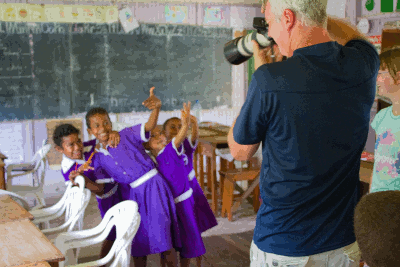
Wednesday 5th October 2011
Dinner ashore was definitely a highlight of our time in Gunu Bay. Vaseva and her family prepared a lovo for us, and then sat us down in her house to eat the meal.
The food was an absolute banquet and we all enjoyed the different vegetables and the different ways they cooked the food. Fresh food out of a lovo (ground oven) is a bit like cooking in a pressure cooker. The meat just melts in your mouth and retains so much flavour.
The only thing we couldn't quite get used to, was the hierarchy of eating. As guests we were sat down around the mat and fed first, while everyone else sat around the room and watched us eat. After we'd had our fill and were relaxing, then the men from the different families came and sat down and started eating. Only when the men had finished eating the food, then could Vaseva and the other women come and sit down to eat. I can't say I'll ever get used to eating while the hosts are sitting watching, waiting for their turn. It just makes me a little self conscious in case I pick up that chicken breast that some other person had their eye on.
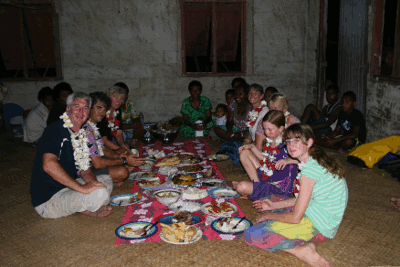
The next morning we had a couple of boat loads of children descend on “Connect4” and “ Ceilydh”. We'd offered that any children that wanted to see our yachts could come down to the waterfront at 7:00am, before school, and Evan would go collect them and bring them out to the yachts. Evan generously offered to play ferry captain as our dinghy outboard is playing up again and one of my now frequent blows at the outboard may have inadvertently gone wide and knocked a small child out of the dinghy – probably not the wisest act when trying to make new friends in a village! But lets face it - this has got to be the most frustrating engine ever known to man! Out of necessity I'm now a whiz at pulling the stupid engine to bits.
I can have the carburettor disconnected, removed and in pieces on the cockpit table in 4 minutes and 16 seconds. I can have it cleaned, reset and rebuilt in a further 5 minutes and 3 seconds. The engine can be fitted back onto the dinghy, fuel connected and started in a blistering 2 minutes and 18 seconds, purring like a kitten. Then 7 minutes and 37 seconds later the stupid thing will be coughing and spluttering and making all kinds of strange farting sounds as it wobbles it's way across the bay, making us the laughing stock of the anchorage. We've never had a risk of the silly thing ever getting stolen as all the locals hear us coming and simply look at us with a sense of bewildered amusement tinged with a drop of sympathy. Yeah – we're the entertainment!
Anyway, enough said about the outboard. Evan brought the kids out and we had the privilege of showing a boat load of wide eyed children around “Connect4”. The luxury of “Connect4” in comparison to their living standard was obvious as soon as they came onboard. We might just as well have shown them the Taj Mahal. We have mattresses in the beds, we have electricity, a fridge, running water, flush toilets and even doors on our rooms. Sometimes it's easy to think that we're doing without many of the modern conveniences, but the reality is that we're Cheryl and Chelsea cooked up before they came. We know they liked them, because more than one disappeared into their pockets when they thought we weren't looking.
After we said goodbye to the children and they went on their way to school, visited the village chief to pay our respects and to thank him for his village's hospitality. We took a few gifts ashore with us, including some D cell batteries that had been asked for and some tinned food. The chief was very excited to see us and offered us some beautiful shells and a hawksbill turtle carapace in return for our gifts. We accepted the shells, even though we may lose a couple to customs when we get to Australia, however we had to decline the very generous gift of the turtle shell, as we know for certain that it's on the “Don't even try to bring it into the country buddy” list. As we were leaving, Bill, the chief, asked us if we had a spare Bible that he might have. We didn't have any spare Bibles onboard, but we did promise that we'd buy one once we got back home to Australia and mail it to him.
Sunday 16th October 2011
After a beautiful sail from Fiji we arrived in the island of Tanna, Vanuatu.
We'd wanted to stop in Tanna because of the active volcano that is said to be one of the most spectacular in the Pacific. As we sailed towards Port Resolution, on the eastern side of Tanna, we could see the cloud of volcano smoke rising from the island, although at the time we had no clue.
We arrived and anchored and went ashore. Port Resolution was named by Captain Cook after his sailing ship “Resolution” in 1774 when he visited the island and, as we later found out, was highly regarded by the natives of the island. Contrary to many other explorers and European visitors who made landfall on these Pacific Islands, Captain Cook seemed to have a knack of befriending the natives and leaving with good will and a measure of mutual respect.

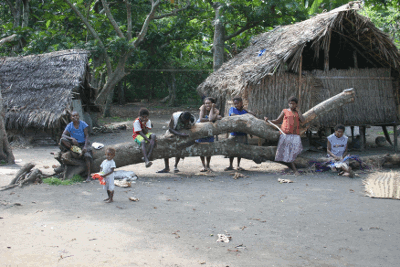
Visiting the island's villages, we met the chief's son who is currently being groomed to take over soon. He spoke very good english and told us that his family has been the presiding chief of the village and the area for generations. He told us a fascinating story, that's no doubt been passed down from generation to generation, about Captain Cook's landing.
His great great (great) grandfather was chief many years ago and was sitting on a mat, watching as Captain Cook's ship sailed into the harbour and dropped anchor. Captain Cook came ashore and as he approached the chief he bent down and scooped up a handful of earth. Holding his hand, filled with dirt, to the chief he motioned for the chief to give him the name of the island. The chief looked at the soil and proclaimed “Tanna” to the strange looking white man. Now “Tanna” in the local language means “Dirt” or “Earth” and wasn't actually the name of the island, however Captain Cook recorded the name of the island as being “Tanna” and since it appeared in all the nautical charts as Tanna, the island has now accepted this name.
The trip to the volcano is going to be remembered as a highlight of our adventure for as long as we live.
We hired a ute to take us and a couple of other yachts to the top of the volcano. The 4WD trip through the bumpy, washed out dirt tracks was an experience in itself as fourteen of us were packed into the back of the ute and bounced along the rutted tracks for near on an hour. We all arrived just below the summit, eager to get out and to take some weight off our bruised backsides as we walked to the summit.


At the top of the volcano we watched a spectacular fire show. At times the explosions were so large that the whole mountain shook and our ears were deafened as the volcano rumbled then spewed tons of molten lava and rock hundreds of metres up into the air with a power and ferocity that can't be imagined.
Standing on the edge of the volcano looking in at the turmoil below, is a humbling experience. To be so close to something of such immense natural power, something that's so purely natural and may explode at any second without regard to human life is an eerie but inspiring feeling.
Standing on the rim, I felt as significant as an ant on the launch pad of a rocket. All around me I was surrounded by the charred and burnt remains of the ejecta from previous explosions. The mountain could have exploded at any time and I couldn't have done a thing to preserve my life. It's hard to describe how I felt, but it felt strangely peaceful to be humbled by the sheer magnitude of nature in all her ferocious beauty.

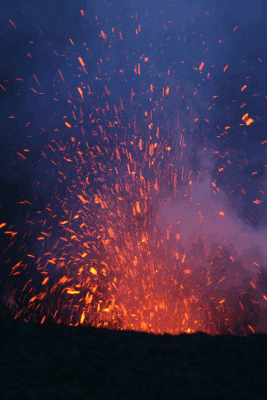
As the sun set, the mountain came alive with the most incredible natural firework show I've ever imagined. Wave after wave of lava was thrown up into the sky, glowing red as the ejecta turned night into an eerie light show that overwhelmed our senses.
From a linguistics point of view, Vanuatu is unique in that it has the highest number of languages per capita of any country in the world. There are approximately 120 different indigenous languages spoken throughout the archipelago, a clear sign that the villages didn't mix and in fact were at war with each other for most of history. In the small island of Tanna alone, the chief told us that there were approximately 15 different languages. These are different languages, not different dialects!
A common language called “Bislama” (a form of pidgin english) was introduced in the early 1800's by the European traders and has grown so much in popularity that it's now used as the language of choice in business. To us English speaking people, the language is simple, cute and often humorous as it conveys a message in plain terms.
As with any country we visit, we always make a point of trying to learn the rudiments of their language, however nowhere have we had as much fun as here. Here's some examples of the sentences and expressions we played with:
Thank you (very much)
Excuse me
My Name is Steve
I'm from Australia
Do you like …
How are you?
I'm fine thanks
How old are you?
Where is the toilet?
And the best one …
Goodbye
Tankyu (tumas)
Skiusmi
Nem blong mi Steve
Mi blong Australia
Yu ting yu likim … ?
Yu oraet?
I oraet, tankyu
Hamas yia blong yu?
Tolet I stap wea?
Mi go now!
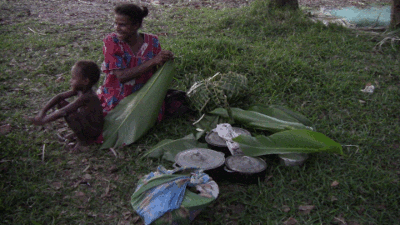
While we were in Tanna, we were invited to a dinner of local food prepared by some of the village women. Being offered a traditionally cooked meal is an amazing opportunity to get involved with the locals and to taste some of the typical foods they eat. Along with Tim, Vicki, Callum and Jessica from “Karinya” we went ashore to enjoy a feast just as the sun was setting.
A couple of the local ladies had prepared a variety of chicken, fish and vegetable dishes that were cooked to perfection and served on a woven palm plate lined with
a pandamas leaf. The food was amazing and has such mouth watering flavour that I just had to keep coming back for more. It seemed so surreal, but also after so much travelling, it seemed like a perfectly normal way to have a dinner; sitting cross legged on the grassy verge on the edge of the beach as the sun goes down, eating a dinner of local delicacies prepared by a couple of the village women as if we were part of their family. We've come such a long way.
Now kava is a popular drink here in Vanuatu, as it is in Fiji. The exception is that in Vanuatu the kava is known to be stronger as they don't dry the root and grind it as they do in Fiji, but rather use it green. A couple of the local men offered us some kava, so we walked over to where they were preparing it. It was explained to us that the kava here isn't ground into a water solution but rather it's chewed directly from the green root itself. As we looked down, we saw a red eyed, hairy faced, local fellow sitting cross legged on the ground with an absolutely huge mouth filled to the brim with kava root. His cheeks were bulging like a chipmunk caught in the act of stealing food and from the corner of his mouth was oozing a green goo that was dribbling down his cheek and congealing in his beard. He had a spaced out look in his eyes and knowing the effects of the kava I figured he had about as much feeling in his face as as a patient does after a root canal. Every couple of minutes he'd lean over and spit his green mouthful of mushed up kava onto a leaf, where it sat looking to all intents and purposes like a vegetarian's vomit.
It was explained to us that traditionally the beautiful young women of the village had the job of chewing the kava, but now the men do it themselves. At this point I was beginning to get a premonition of what was coming and I can tell you, I was starting to get more than a little nervous. Just as my mind was piecing together the situation, our host asked us if we'd like to try the kava. In a pure act of self preservation I quickly volunteered that I'd had kava before in Fiji, but if it was allowed I'd like to try chewing the kava root! This, I hoped was going to be the lesser of two evils. At least I couldn't catch Hep-B from the kava root … could I? I was passed the kava root and I tried to find a piece that hadn't been dribbled on by my chewing friend who by this stage had lost all sense that he even had a mouth. I tore off a strip of kava root which had the initial taste and texture of chewing a tree branch and started grinding it in my mouth. Kava has to be the only legal narcotic still in wide circulation and as I chewed I could feel first my toungue, then my lips, then the rest of my mouth and throat numbing up in a manner not unlike the feeling when you've just been given a local anaesthetic by the dentist.
As I chewed my kava root, frequently wiping my numb lips just to make sure I wasn't drooling like my compadré. Our host offered the others some kava and now being aware of what was about to happen, all tried politely to decline the offer, however our host was insistent. Cheryl, with the prohibitive conscience and not wanting to offend anybody finally relented despite my murmurings of “here come the Hep-B shots” through my now thoroughly numb face.
Our host picked up a small piece of coconut fibre material and scooped in a generous handful of the green gooey looking stuff that was sitting on the leaf, compliments of our professional chewer friend in the corner. The pre-chewed green kava mash was placed in the hessian like bag and a small cup of water was added, then squeezed directly into a coconut cup which was promptly handed to Cheryl. Reluctantly, she accepted the cup and took a small sip, her mouth going totally numb in the process. This kava was very strong, but it was the memory of how the kava was prepared that made her feel ill. Trying her hardest not to pull a sour face, she passed the cup back to our host, but he wouldn't accept it. He motioned the cup back to her, urging her to finish the kava. She took another small sip, and tried to pass it off to Tim or Vicki, but sadly she was left holding the cup. She tried to pass the cup to me, but there was no way I was drinking what that guy had been chewing, so she was on her own - I'd rather kiss a dugong! With a final act of resignation to her position, she downed the last of the cup, praying that she hadn't caught anything too permanent.
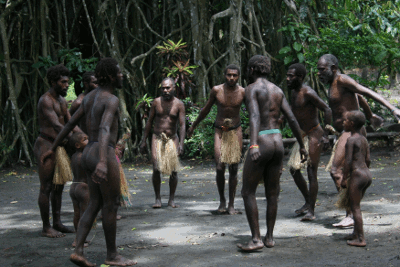
We arranged a trip inland to a more traditional village on Tanna and got to see how the natives used to live. The guys put on a traditional dance for us, wearing a little tapa cloth sheath wrapped around their private parts and with a little grass skirt that covered the front part only. Apparently exposed backsides are the norm here. It made for a fun afternoon and it was nice to hear the village chief explain the traditional ways of the islanders.
One interesting thing about some of the Tanna islanders is that many of them believe in what is called the “Cargo Cult”. Basically they believe that one day their messiah is going to return by ship bringing huge cargos of material wealth for them all. Boy are they in for a shock!
Monday 24th October 2011
Everything is a rush here right now. We've got a million jobs to do before we can leave tomorrow and it seems like we'll need at least another week to get them all done. The boat feels very crowded right now as we pull everything to bits to clean and prepare for customs and quarantine in Australia. I'm still trying to get my adverts online for the sale of “Connect4” and no matter how hard I try they just don't seem to go through. When I was online today, our good friend Michelle (aka Michelle and David our best friends) came online on Skype and made the mistake of asking how I was … she copped an earful, poor girl. She asked and I offloaded onto her big time. I'm probably on her ignore list now!!
Tuesday 25th October 2011
It's only taken two whole days and numerous frustrations, but I've finally got the “For Sale” web page up and running and I've listed “Connect4” in the Trade-A-Boat magazine and online at www.boatsonline.com.au. Phew, what a job! We were meant to leave Vanuatu today, in company with a couple of other boats we're friendly with, but unfortunately we weren't ready. We've still got too many jobs to do before we can leave, which is making us all a little grumpy.
The second problem we're facing is that although it's only 1000NM from here to Bundaberg, we have to watch the weather for this last passage as it can turn nasty quickly – and we don't want that! A Tuesday departure looked like a weather window, but now we've missed it, we have to wait for the next opportunity. There's nothing worse than being delayed when you have a plan.
The third thing that's making us all a little “narky” is all the hoops we've had to jump through to get “Connect4” into Australia. The latest and greatest issue right now is that we're being classed as an “Importer of Ozone Depleting Gasses” because we have refrigeration gas in our fridges and we're importing our yacht into Australia. We were given two options: 1)Pay the princely sum of $400.00 to apply for a license to import an Ozone Depleting Gas into the country, or 2) Remove the gas from our fridges. Some choice!
I wrote a couple of emails to the government body responsible for this piece of legislation and requested that I be given an exemption as I'm not really an importer of gas, I'm simply bringing my yacht home to Australia and I don't intend to make a commercial venture of on-selling my fridge gas. They replied that the legislation is aimed at stopping ozone depleting gasses from being brought into Australia in order to protect the environment. Perhaps this is their pipe dream that by taxing us cruising yacht another $400 that in some way they're protecting the environment, but the bottom line is that I need gas in my fridge. Either I pay $400 in additional fees for this licence (which feels like a grab for money) or I pay a refrigeration mechanic to remove the gas from my fridges before I leave Vanuatu, which sadly is more than likely going to be vented direct to atmosphere, and then get it re-gassed when I get to Australia with more of the gas they don't want imported into the country. Go figure!!! Sadly, I know more than a few yachts who are planning to vent their own gas just as they arrive in Australian waters. Anyway, I guess as I get closer to Australia and all it's politics I have to expect to start feeling the pains of Australian legislation. I should consider myself lucky that I haven't had to vote for the last two years.
The good news is Michelle came up again on Skype today so I guess I'm not on the ignore list. What a great friend. Friends are the ones who stand closest when you're having a bad day.
Wednesday 26th October 2011
To add insult to injustice, I had the refrigeration mechanic come visit today to degas the fridges. He questioned the sanity of the Australian Government, informing me that he couldn't see why the government would have an issue with my fridge gas as the R134A that's in my fridge IS NOT an ozone depleting gas. R134A was designed specifically so that it wouldn't damage the ozone layer. Go figure - It's looking more and more like a bureaucratic grab for money by politicians who want to look like they're doing the right thing rather than actually doing anything with purpose.
Sunday 30th October 2011
Well, here I am, sitting, writing another blog. Tomorrow we're heading off on our final proper offshore passage; Vanuatu to Bundaberg via Chesterfield reef, a passage of approximately 1000NM. If all goes well the trip should take between 7 and 10 days, excluding the time we stop in Chesterfield Reef.
I've been pondering this last passage, and what it'll be like making landfall in Australia; returning home. I keep telling myself that making landfall in Australia will be the realisation of a dream completed, a highlight, something to get excited about. I am excited, truly! We've come such a long way over the last two years - in distance we've sailed over 16,000NM but that's not the “long way” I'm talking about here. As a FAMILY, we've come a long way. We set off sailing on a yacht far bigger than anything we'd ever set foot on, let alone sailed! Our total sailing experience was exceeded the first week we took “Connect4” down the coast of Turkey! We set off green, uncoordinated and with nothing more than a dream and a yacht we'd just bought. Yet the four of us, our family, made a formidable team and we came through. The first time we practised manoeuvring “Connect4” out of one berth and into another. The first time we practised anchoring. The first time we set sail and almost lost sight of land. The first overnight passage. The first time we had to really rely on each other. The first time we saw in broad daylight the fears, strengths and the weaknesses in each other. The first time we realised that succeeding was about accommodating each others fears and weaknesses and working together to bring out the strengths, to bring out the best in each other. The times we've rallied as a family to overcome some obstacle and the adulation of beating a problem, together. You see, we've come to realise that working together as a family, 24x7 inside a small floating zoo, where quality of life and for that matter, sometimes even survival, depends on the way that we work together, is is a whole lot different to anything we'd ever experienced before. But, we've come through and I feel we're closer for the experience.
So how do I feel about coming home? I've mixed emotions that will continue to stir and mix, the closer I get to home. In once sense, I feel I'm ready to finish this adventure. It was only ever going to be 2 years and I'm looking forward to getting back to my home. I'm looking forward to starting my next engineering project and I'm even looking forward to mowing my lawn and planting some of my vegetables. On the flip side, I love sailing for the experiences it brings. Nowhere are you as free as you are when you're on the open ocean, being blown from one world of adventure to the next. I love the time we spend as a family, and the things we experience, together, as a family, as it should be. The more I sail and the more I see, the more I have a lust for exploring further, to see more places and to meet more people, and to experience new worlds, different people, different cultures.
We head off tomorrow, and the next formal stop will be Bundaberg where it will all finish. It's with a measure of remorse that I finally put “Connect4” on the market the other day. We're hoping a buyer will come along soon, perhaps another family will come along and take care of “Connect4” as we have and they'll sail her and have an adventure like we've had. I hope someone buys her who has a dream to bring their family closer. I hope someone experiences what we've experienced.
Tomorrow we head off and when we land in Bundaberg, it'll all change.